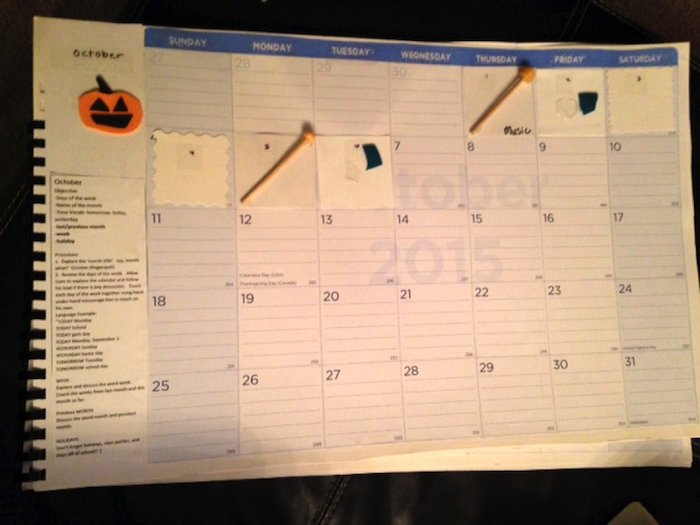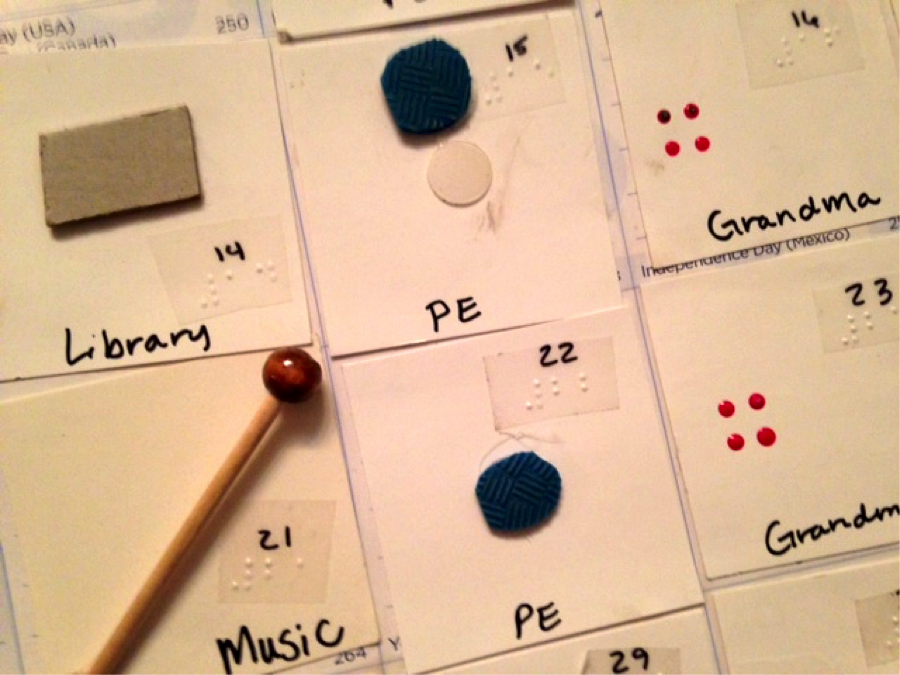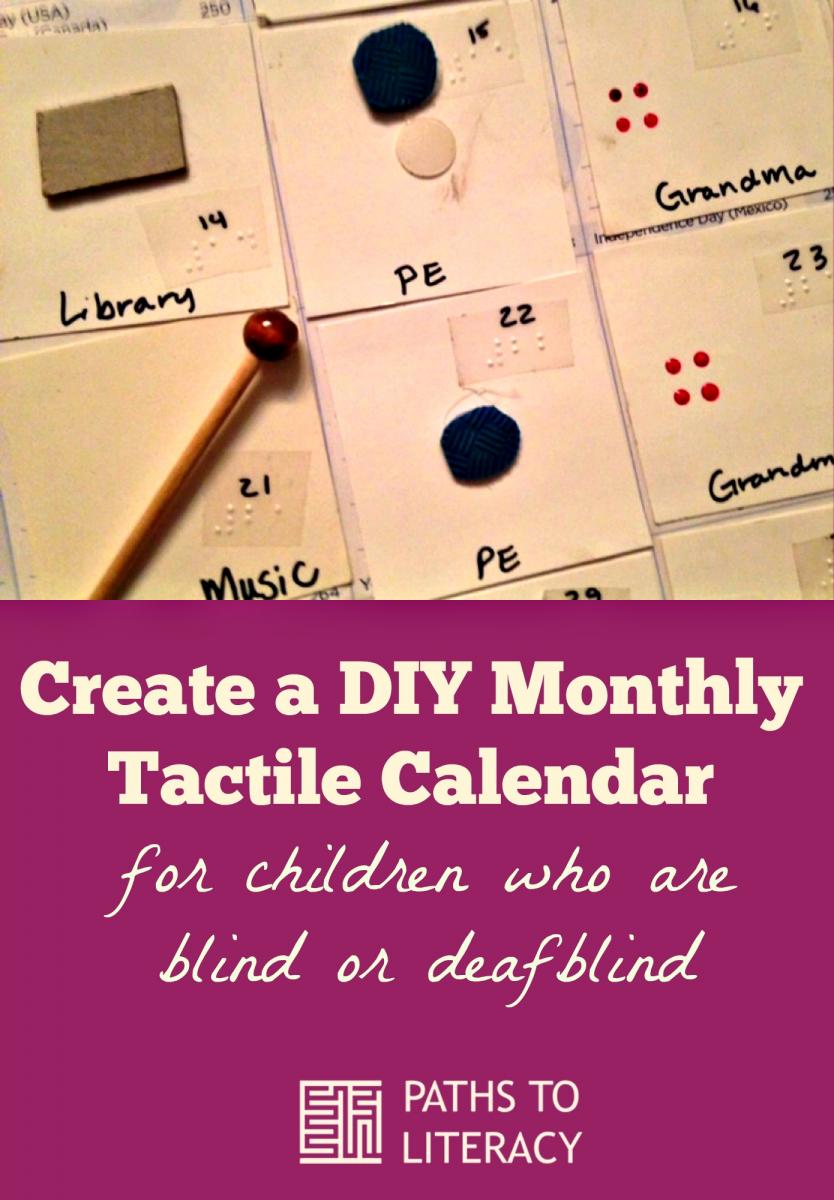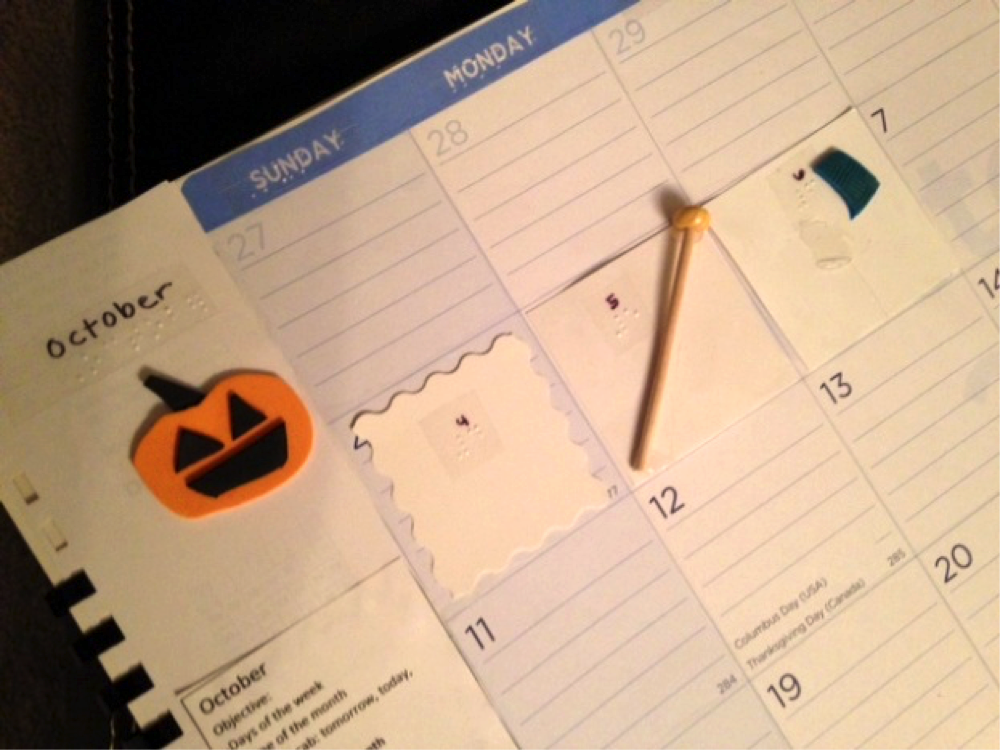Monthly Tactile Calendar
Submitted by Liamsmom on Jan 05, 2016

My son Liam is in first grade in a mainstream setting. He is deafblind. In his classroom, his peers do "calendar" time together in the morning. I wanted to Liam to be able to be included in this activity in a way that was meaningful and accessible to him. I created a monthly tactile calendar for him to use at school and I wanted it to be larger in size so that it had room for the object symbols and Braille I wanted to add. I know there is a great tactile calendar available "pre-made" (Classroom Calendar Kit APH) however, I wanted to be able to save all of the calendar "work" from month to month, so that Liam would be able to learn about and discuss past events, present events and also future. I "bound" the pages together to form a large calendar book.
Materials:
-
Teacher desk calendar glued onto posterboard. I used Elmer's glue to add slightly raised line on the calendar grid.
-
Calendar objectives and routine printed off for each month (lesson plan)
-
Brailled title for each month. Days of the week labeled in braille.
-
Tactile symbol to represent each month (e.g. Christmas tree for December, leaf for September, pumpkin for Halloween, etc..)
-
Calendar squares for each day of the month to be glued on. The squares include a symbol and/or braille words for one special event that happens each day.
-
Binding machine (most elementary schools have these in their supply room).
-
Braille numbers to place on the "calendar squares"
-
Box to organize the calendar pieces.
Procedure:
 Currently he is gluing a calendar square onto the calendar for each day of the week as it happens. (Eventually the "days" will already be placed for him. The purpose for gluing on each day is to get a hands-on feel for how the calendar works. For example, the squares can represent Today, tomorrow, yesterday, etc.) He also "sticks" the number for the date on each square every morning. We use object symbols and braille paired for one special thing that happens special to that day (for example: Grandma picking him up days, music days, Library, Halloween party, etc.). Eventually we will slowly "lose" the objects and use braille only. And, eventually, the calendar can become smaller as well. I "bound" the calendar pages together so that he can go back and learn/talk about past events and eventually future events. The calendar "grid" has thin raised lines (I traced them with Elmer's liquid glue.). There is also a tactile symbol to go with each month. Brief lesson plans for his intervener/interpreter are on the sides to use as a guideline with language and time concept objectives. The "lesson plans" on the side ensure consistency with the calendar morning routine along with stating clear learning objectives.
Currently he is gluing a calendar square onto the calendar for each day of the week as it happens. (Eventually the "days" will already be placed for him. The purpose for gluing on each day is to get a hands-on feel for how the calendar works. For example, the squares can represent Today, tomorrow, yesterday, etc.) He also "sticks" the number for the date on each square every morning. We use object symbols and braille paired for one special thing that happens special to that day (for example: Grandma picking him up days, music days, Library, Halloween party, etc.). Eventually we will slowly "lose" the objects and use braille only. And, eventually, the calendar can become smaller as well. I "bound" the calendar pages together so that he can go back and learn/talk about past events and eventually future events. The calendar "grid" has thin raised lines (I traced them with Elmer's liquid glue.). There is also a tactile symbol to go with each month. Brief lesson plans for his intervener/interpreter are on the sides to use as a guideline with language and time concept objectives. The "lesson plans" on the side ensure consistency with the calendar morning routine along with stating clear learning objectives.  Note: When my son began learning about calendar systems, he started with a simple anticipation calendar system and then moved to a daily calendar. He needed to have an understanding of certain time vocabulary and concepts and also symbols before he was ready for a monthly calendar. To learn more about calendars for children with visual impairments and/or multiple disabilities, I used the book "Calendars for Students With Multiple Impairments Including Deafblindness". It's important to assess and see what would be an appropriate place to start with your child. There are many different options that can be used when creating a tactile calendar. It's important to consider the level of your child, interest, learning objectives, etc... Calendars can be modified and adapted for all children at all levels.
Note: When my son began learning about calendar systems, he started with a simple anticipation calendar system and then moved to a daily calendar. He needed to have an understanding of certain time vocabulary and concepts and also symbols before he was ready for a monthly calendar. To learn more about calendars for children with visual impairments and/or multiple disabilities, I used the book "Calendars for Students With Multiple Impairments Including Deafblindness". It's important to assess and see what would be an appropriate place to start with your child. There are many different options that can be used when creating a tactile calendar. It's important to consider the level of your child, interest, learning objectives, etc... Calendars can be modified and adapted for all children at all levels.Examples of symbols used:
Gym day: Piece of a rubber ball
Music Day: Wooden dowel to represent the wooden mallet used on the xylophone in class
Library Day: piece of chipboard that is used on the pages of his library books.
Special day: We have a special star object for when special events happen (ex: A family friend brought him lunch, Firefighters came to speak to the class, etc.).



Comments
I always love reading your
Thanks for the tip!